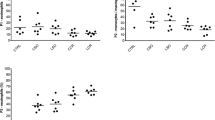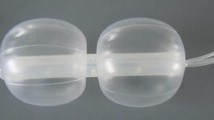Abstract
Background
Transrectal natural orifice specimen extraction (NOSE) avoids abdominal organ retrieval during laparoscopic procedures and may reduce surgical trauma. However, this has not been proven clinically and transrectal peritoneal contamination is feared to cause infectious complications. This experimental study was designed to evaluate inflammatory response and peritoneal contamination after transrectal NOSE versus mini-laparotomy.
Methods
24 German Landrace pigs underwent transrectal NOSE (N = 12) or mini-laparotomy (N = 12) for standardized extraction of water-instilled balloon. Blood samples were taken for analysis of leucocytes, CRP, IL-6, IL-10, and TNFα at 6, 12, 24, 48, 72 h as well as 7 and 14 days postoperatively. After 14 days laparoscopy was performed to inspect the abdomen and for microbiological swab sampling.
Results
Leucocytes were higher in the NOSE group at 72 h (19.3 ± 3.9/nl vs. 15.8 ± 4.2/nl, p = 0.046). IL-6 was lower in the NOSE group at day 7 (165 ± 100/nl vs. 306 ± 70/nl, p = 0.030). No difference was found comparing inflammatory parameters at all other time points. No difference was found regarding peritoneal contamination, which was 58.3% (7/12) in the NOSE group and 41.7% (5/12) in the MiniLap group (p = 0.414).
Conclusions
The results suggest a pronounced acute inflammatory response after transrectal NOSE compared to mini-laparotomy, while late cytokine response seems to be less after transrectal NOSE, which may reflect less intense wound healing process. Using standardized rectal decontamination and endolumenal colon occlusion transrectal NOSE seems to be safe and comparable to mini-laparotomy with regard to peritoneal contamination. Clinical evidence is needed now to weight transrectal NOSE against mini-laparotomy during laparoscopic surgery.



Similar content being viewed by others
Abbreviations
- NOSE:
-
Natural orifice specimen extraction
- NOTES:
-
Natural orifice translumenal endoscopic surgery
References
Lehmann KS, Ritz JP, Wibmer A, Gellert K, Zornig C, Burghardt J, Büsing M, Runkel N, Kohlhaw K, Albrecht R, Kirchner TG, Arlt G, Mall JW, Butters M, Bulian DR, Bretschneider J, Holmer C, Buhr HJ (2010) The German registry for natural orifice translumenal endoscopic surgery: report of the first 551 patients. Ann Surg 252:263–270. doi:10.1097/SLA.0b013e3181e6240f
Zorron R, Phillips HN, Coelho D, Flach L, Lemos FB, Vassallo RC (2012) Perirectal NOTES access: “down-to-up” total mesorectal excision for rectal cancer. Surg Innov 19:11–19. doi:10.1177/1553350611409956
Leroy J, Costantino F, Cahill RA, D’Agostino J, Morales A, Mutter D, Marescaux J (2011) Laparoscopic resection with transanal specimen extraction for sigmoid diverticulitis. Br J Surg 98:1327–1334. doi:10.1002/bjs.7517
Wolthuis AM, Fieuws S, Van Den Bosch A, de Buck van Overstraeten A, D’Hoore A (2015) Randomized clinical trial of laparoscopic colectomy with or without natural-orifice specimen extraction. Br J Surg 102:630–637. doi:10.1002/bjs.9757
Ni Choileain N, Redmond HP (2006) Cell response to surgery. Arch Surg 141:1132–1140. doi:10.1001/archsurg.141.11.1132
Costantino FA, Diana M, Wall J, Leroy J, Mutter D, Marescaux J (2012) Prospective evaluation of peritoneal fluid contamination following transabdominal vs. transanal specimen extraction in laparoscopic left-sided colorectal resections. Surg Endosc 26:1495–1500. doi:10.1007/s00464-011-2066-6
Sidhwa F, Itani KMF (2015) Skin preparation before surgery: options and evidence. Surg Infect (Larchmt) 16:14–23. doi:10.1089/sur.2015.010
Senft JD, Carstensen B, Mischnik A, Warschkow R, Müller-Stich BP, Linke GR (2015) Endolumenal colon occlusion reduces peritoneal contamination during a transrectal NOTES procedure: a controlled porcine survival study. Surg Endosc. doi:10.1007/s00464-015-4582-2
Müller-Stich BP, Senft JD, Lasitschka F, Shevchenko M, Billeter AT, Bruckner T, Kenngott HG, Fischer L, Gehrig T (2014) Polypropylene, polyester or polytetrafluoroethylene-is there an ideal material for mesh augmentation at the esophageal hiatus? Results from an experimental study in a porcine model. Hernia 18:873–881. doi:10.1007/s10029-014-1305-x
Linke GR, Carstensen B, Kähler G, Zerz A, Shevchenko M, Warschkow R, Lasitschka F, Kenngott HG, Senft J, Müller-Stich BP (2013) Endolumenal colon occlusion device for transanal and transrectal surgery–a porcine feasibility study. Langenbecks Arch Surg 398:595–601. doi:10.1007/s00423-013-1074-5
Senft JD, Gath P, Dröscher T, Müller PC, Carstensen B, Nickel F, Müller-Stich BP, Linke GR (2016) New device for transrectal trocar placement and rectal sealing for NOTES: a porcine in vivo and human cadaver study. Surg Endosc 30:4383–4388. doi:10.1007/s00464-016-4756-6
Mischnik A, Mieth M, Busch CJ, Hofer S, Zimmermann S (2012) First evaluation of automated specimen inoculation for wound swab samples by use of the Previ Isola system compared to manual inoculation in a routine laboratory: finding a cost-effective and accurate approach. J Clin Microbiol 50:2732–2736. doi:10.1128/JCM.05501-11
Fritz S, Hackert T, Hartwig W, Rossmanith F, Strobel O, Schneider L, Will-Schweiger K, Kommerell M, Büchler MW, Werner J (2010) Bacterial translocation and infected pancreatic necrosis in acute necrotizing pancreatitis derives from small bowel rather than from colon. Am J Surg 200:111–117. doi:10.1016/j.amjsurg.2009.08.019
Baker TA, Romero J, Bach HH 4th, Strom JA, Gamelli RL, Majetschak M (2012) Systemic release of cytokines and heat shock proteins in porcine models of polytrauma and hemorrhage*. Crit Care Med 40:876–885. doi:10.1097/CCM.0b013e318232e314
Bulian DR, Knuth J, Cerasani N, Sauerwald A, Lefering R, Heiss MM (2013) Transvaginal/transumbilical hybrid-NOTES-versus 3-trocar needlescopic cholecystectomy: short-term results of a randomized clinical trial. Ann Surg. doi:10.1097/SLA.0000000000000218
Kloosterman T, von Blomberg BM, Borgstein P, Cuesta MA, Scheper RJ, Meijer S (1994) Unimpaired immune functions after laparoscopic cholecystectomy. Surgery 115:424–428
Lin Z-Q, Kondo T, Ishida Y, Takayasu T, Mukaida N (2003) Essential involvement of IL-6 in the skin wound-healing process as evidenced by delayed wound healing in IL-6-deficient mice. J Leukoc Biol 73:713–721
Acknowledgements
The authors wish to thank Béivin Pyne for revising this manuscript as a native English speaker.
Funding
This study was funded by institutional means of the University of Heidelberg.
Author information
Authors and Affiliations
Corresponding author
Ethics declarations
Disclosures
This study was funded solely by institutional means from the University Hospital of Heidelberg. The authors Jonas D. Senft, Tilman Dröscher, Philip Gath, Philip C. Müller, Adrian Billeter, Beat P. Müller-Stich and Georg R. Linke have no conflict of interest or financial ties to disclose.
Rights and permissions
About this article
Cite this article
Senft, J.D., Dröscher, T., Gath, P. et al. Inflammatory response and peritoneal contamination after transrectal natural orifice specimen extraction (NOSE) versus mini-laparotomy: a porcine in vivo study. Surg Endosc 32, 1336–1343 (2018). https://doi.org/10.1007/s00464-017-5811-7
Received:
Accepted:
Published:
Issue Date:
DOI: https://doi.org/10.1007/s00464-017-5811-7




